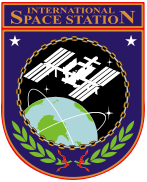Mobile Servicing System
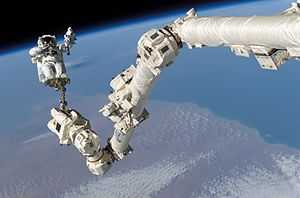
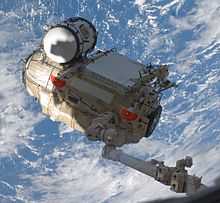
The Mobile Servicing System (MSS), better known by its primary component Canadarm2, is a robotic system and associated equipment on the International Space Station (ISS). Launched to the ISS in 2001, it plays a key role in station assembly and maintenance; it moves equipment and supplies around the station, supports astronauts working in space, and services instruments and other payloads attached to the ISS. Astronauts receive specialized training to enable them to perform these functions with the various systems of the MSS.
The MSS is composed of the actual arm called Space Station Remote Manipulator System (SSRMS), the Mobile Remote Servicer Base System (MBS) and the Special Purpose Dexterous Manipulator (SPDM, also known as Dextre or Canada hand). The system can move along rails on the Integrated Truss Structure on top of the US provided Mobile Transporter cart which hosts the MRS Base System. The system's control software was written in the Ada 95 programming language.[1]
The MSS was designed and manufactured by MDA Space Missions (previously called MD Robotics; previously called SPAR Aerospace) for the Canadian Space Agency's contribution to the International Space Station.
Canadarm2
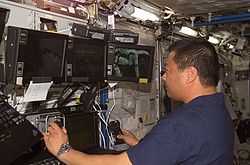
Launched on STS-100 in April 2001, this second generation Canadarm is a larger, more advanced version of the space shuttle's original Canadarm. Canadarm2 is 17.6 m (58 ft) when fully extended and has seven motorized joints. It has a mass of 1,800 kg (4,000 lb) and a diameter of 35 cm (14 in). The arm is capable of handling large payloads of up to 116,000 kg (256,000 lb) and was able to assist with docking the space shuttle. Officially known as the Space Station Remote Manipulator System (SSRMS), it is self-relocatable and can move end-over-end to reach many parts of the Space Station in an inchworm-like movement. In this movement, it is limited only by the number of Power Data Grapple Fixtures (PDGFs) on the station. PDGFs located around the station provide power, data and video to the arm through its Latching End Effectors (LEEs). The arm can also travel the entire length of the space station truss using the Mobile Base System.
Most of the time the arm operators see what they are doing by looking at the three Robotic Work Station (RWS) LCD screens. The MSS has two RWS units: one located in the Destiny module (US Lab module) and the other in the Cupola. Only one RWS controls the MSS at a time. The RWS has two sets of control joysticks: one Rotational Hand Controller (RHC) and one Translational Hand Controller (THC). In additional to this is the Display and Control Panel (DCP) and the Portable Computer System (PCS) laptop.
Mobile Base System
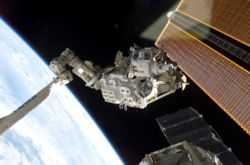
The Mobile Base System (MBS) is a base platform for the robotic arm. It was added to the station during STS-111 in June 2002. The platform rests atop the Mobile Transporter (installed during STS-110, designed and manufactured by Northrop Grumman Astro Aerospace in Carpinteria, CA), which allows it to glide 108 metres down rails on the station's main truss.[2] When Canadarm2 is attached to the MBS, it has the ability to travel to work sites all along the truss structure. The top speed of the Mobile Transporter is about 2.5 cm per second.[3] The proper and complete name of the MBS is the "Mobile Remote Servicer Base System". It is constructed of aluminium with an expected service life of a minimum of 15 years. Like Canadarm2 it was built by MD Robotics.[4][5]
The MBS is equipped with 4 Power Data Grapple Fixtures, one at each of its four top corners. Either of these can be used as a base for the two robots, Canadarm2 and Dextre, as well as any of the payloads that might be held by the robots. The MBS also has 2 locations to attach payloads. The first is the Payload/Orbital Replacement Unit Accommodations (POA). This is a device that looks and functions much like the Latching End Effectors of Canadarm2. It can be used to park, power and command any payload with a grapple fixture, while keeping Canadarm2 free to do something else. The other attachment location is the MBS Common Attachment System (MCAS). This is another type of attachment system that will primarily be used to host a number of scientific experiments.[4]
The MBS also supports astronauts during Extra-vehicular activities. It has locations to store tools and equipment, foot-restraints, handrails and safety tether attachment points as well as a camera assembly. If needed, it is even possible for an astronaut to "ride" the MBS while it moves along the truss rails.

Special Purpose Dexterous Manipulator
The Special Purpose Dexterous Manipulator, or "Dextre", is a smaller two-armed robot that attaches to the end of Canadarm2. The arms and tools are capable of handling the delicate assembly tasks and changing Orbital Replacement Units (ORUs) currently handled by astronauts during space walks. Testing was done in the space simulation chambers of the Canadian Space Agency's David Florida Laboratory in Ottawa. The manipulator was launched to the station 11 March 2008 on STS-123.
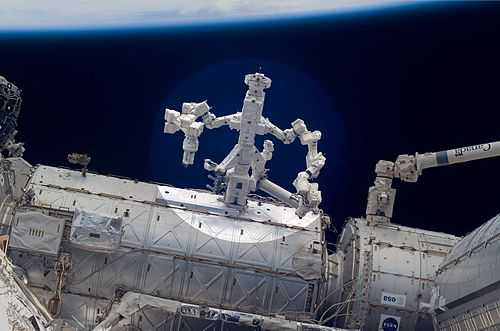
Enhanced ISS Boom Assembly
Main article: ISS Boom Assembly Installed on May 27, 2011, is a 50-foot boom with handrails and inspection cameras, attached to the end of Canadarm2.
-
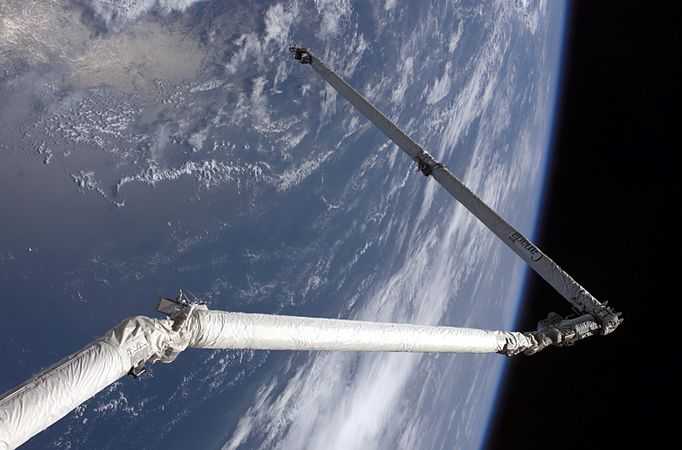
Shuttle Remote Manipulator System (RMS) holding OBSS boom on STS-114
-

Astronaut Scott Parazynski at the end of the OBSS boom making repairs to the P6 solar array
Other ISS robotics
The station received a second robotic arm during STS-124, the Japanese Experiment Module Remote Manipulator System (JEM-RMS). The JEM-RMS will be primarily used to service the JEM Exposed Facility. A third robotic arm, the European Robotic Arm (ERA) is scheduled to launch alongside the Russian-built Multipurpose Laboratory Module during 2015.
Connected to Pirs, the ISS also has two Strela cargo cranes. One of the cranes can be extended to reach the end of Zarya. The other can extend to the opposite site and reach the end of Zvezda. The first crane was assembled in space during STS-96 and STS-101. The second crane was launched alongside Pirs itself.
See also
- MacDonald Dettwiler and Associates (MDA), the makers of Canadarm2
- Canadarm, which was used on the Space Shuttle program
- European Robotic Arm, a third robotic arm to be installed on the ISS
- The Remote Manipulator System, used on the ISS module Kibo
- Dextre, also known as the Special Purpose Dexterous Manipulator (SPDM), used on the ISS
- Strela, a crane used on the ISS to perform similar tasks as the Mobile Servicing System
References
- ↑ "Case Study: MDA - Canadian Space Arm". AdaCore. Retrieved 2009-10-15.
- ↑ http://www.asc-csa.gc.ca/eng/iss/mobile-base/backgrounder.asp
- ↑ "The Slowest and Fastest Train in the Universe". NASA.
- ↑ 4.0 4.1 "CSA - STS-111 - Mobile Base System - MBS Design". Canadian Space Agency. Retrieved 2008-03-15.
- ↑ "CSA - STS-111 - Mobile Base System - Backgrounder". Canadian Space Agency. Retrieved 2008-03-15.
External links
| Wikimedia Commons has media related to Mobile Servicing System. |
- ISS Assembly: Canadarm2 and the Mobile Servicing System
- Canadian Space Agency information about Canadarm2
| |||||||||||||||||||||||||||||||||||||||||||||||||||||||||||||||||||
| ||||||||||||||||||||||||||||
